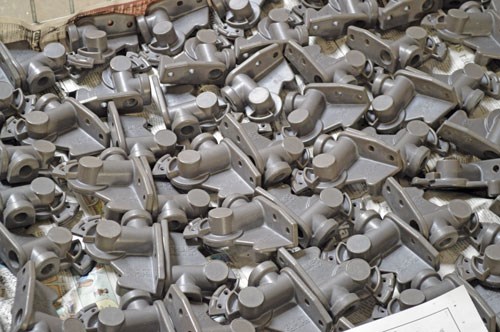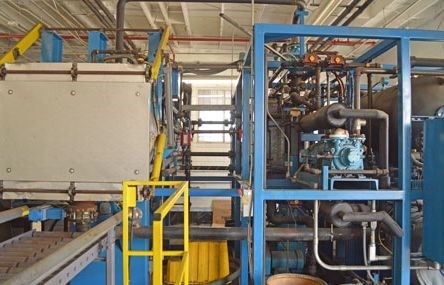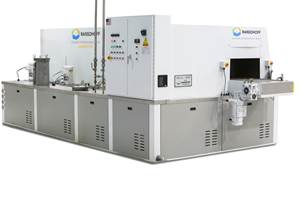Appreciating the Value of Secondary Production Processes
Although operations such as cleaning often can be the deciding factor in the production of an acceptable part, their significance is often understated.
Often considered non-value-added steps, post-process operations such as cleaning, deburring, and even gaging can become low priorities, leaving a shop rushing through them or ignoring opportunities to improve the way they are carried out for the sake of shorter lead times and lower costs. But this approach can be dangerous, as such processes typically have a direct effect on the final appearance, quality and performance of the part.
In some critical applications such as medical and aerospace, the importance of the part finish is obvious. But in others it might not be so clear. In either case, though, when the parts go out the door, the customers better be happy with what they receive. The further into the production schedule that flaws are found, the more costly they become, and when they’re found while in the customer’s hands, the biggest expense may be the loss of future business.
High Quality is the Goal
If a company is aware of a quality issue with its products, it will take the proper measures to resolve the problem. Sometimes the issue may be the result of a particular step of the production process that is flawed in some way. Sometimes the issue is an inherent part of the product, regardless of who is producing it, and an entirely different method must be developed or a step added to compensate for the shortcoming.
Aluminum die castings are a critical part of the auto industry. Engine blocks, transmissions, air conditioning systems and other components use aluminum die castings. But these castings have a specific problem with porosity that can be partially controlled, but not eliminated. Castings by their nature go from a liquid to a solid. During this densification process, the casting shrinks, and as it cools at different rates, it develops porosity.
This porosity can lead to leakage in the casting unless other steps are taken to counteract the effect. The auto industry has been fighting this issue for years, even as it has continued to improve castings. The biggest influencer on casting quality—atmosphere—is something that cannot be controlled, and humidity and moisture have a significant, yet widely ranging effect on porosity.
Generally, after the casting process, the part is machined, and then it is either leak tested to identify leak paths from one side to another or it is impregnated to close the porosity. But the bottom line is that if porosity is not controlled, leaks will occur.
Delivering on a Need
Imtech of California Inc. (Santa Fe Springs) is a full-service job shop offering services for parts cleaning, impregnating and final leak testing. The company tailors programs specific to customer needs. Imtech’s large autoclaves and specialized impregnation techniques are designed to handle a range of part sizes and quantities.
According to company president, Peter Gebhard, it would be quite difficult to get through a day without touching something that companies such as his didn’t have a part in producing. “Every car, truck aircraft, water treatment facility and pump has an impregnated part. The list is endless,” he says. In this location since 1988, the company clearly serves many different markets.
Mr. Gebhard explains that by resolving the problem of the subsurface porosity, the ultimate result of the surface finishing, whether painting, plating, anodizing, and so on, is better and the number of rejects is substantially reduced. In the case of aluminum castings, he says companies often lose between 10 and 20 percent of production without impregnation. The cost of impregnation is generally less than 5 percent of the cost of the casting itself, so it easily offsets those potential losses from rejected parts.
The Need for Clean
Preparing a part’s surface for final finishing operations goes beyond impregnation. Dealing with a variety of manufacturers such as automotive and aerospace, Imtech’s cleaning line has delivered on significant demands. About half of the parts that the company processes go through its vapor degreasing system. The more difficult the porosity-associated issue is, whether it’s a finishing or a pressure tightness problem, the more likely it is to be cleaned.
According to Mr. Gebhard, people don’t always realize vapor degreasing is still a viable option, but with the right control processes in place, it can indeed serve as the best option in many applications. “When dealing with the porosity in castings, water-based cleaning has specific limitations,” he says. “You start with water—the cleaning media—and it has a surface tension in the mid-70 dynes. To get it to clean, you have to lower that surface tension with detergents, just like when washing dishes. Adding a surfactant helps to break down the dirt in an electrochemical reaction.”
But there is still a limitation because even after adding the chemistry to the cleaning water and adding ultrasound energy or impingement energy (a spray), or some sort of washing energy such as tumbling, the surface tension continues to be kind of high, and the water itself cannot enter the pores that it needs to. Oils and other contaminants have a much lower surface tension. “To deal with these contaminants, the perchloroethylene solvent that we use is down around 2 dynes, and when it’s at temperature, it’s below 1,” Mr. Gebhard explains. “It easily gets into the porosity and displaces the contaminants. Then, we take it out through an evaporation process, and we have a clean part.”
The System
Imtech has been using a Serec airless vapor degreasing system in its facility since 1998, and one was added about 2 years ago. Mr. Gebhard was involved in the development of the original system in 1990 in response to the Clean Air Act. While this legislation did not ban halogenated solvents, it placed strict guidelines on their use. This vapor degreasing system uses the solvents without losing them like the open-top degreasers did.
According to Bill McCormick, president at Serec, roughly 80 percent of the systems sold by the company are customized to fit the customers’ applications. Such is the case with the system at Imtech, designed for a variety of metals and part sizes. The system is an airless vacuum machine—a closed-loop system with built-in distillation, heated vacuum solvent recovery. It features low emissions and more than 97-percent recovery from the waste stream. Processing under vacuum, there is no solvent/air interface. With no air in the chamber, it is able to perform deep cleaning and drying on complex features.
Getting it Done
Cleaning can be an expensive step in the production process, but it’s also valuable. Shops must determine the value based on losses that would be incurred without proper cleaning procedures. Shops that take cleaning seriously, and follow the proper procedures and protocols, are the ones that have fewer reject rates and are the top performers in the industry. Mr. Gebhard says, “You can tell when you walk in the doors, by the way a shop is set up and the way they work, that they are serious about cleanliness. These are the shops that will be in business down the road.”
One Imtech customer had been struggling with a cast titanium ring with an interior diamond coating. Experiencing multiple failures with the part, the company thought impregnation may be the solution. By running UV light inspections, Imtech determined that these parts, worth thousands of dollars and previously thought to be “cleanroom quality,” had fingerprints on the coatings. While impregnation was useful for these parts, the real impact was the addition of proper cleaning, which is critical for the success of the parts. “Anyone having adhesion problems should first look at their cleaning procedures,” says Mr. Gebhard. “If the material surface is not prepared appropriately, they’ll never have success. It’s an old issue, but people still don’t pay enough attention to it.”
Related Content
Sita’s CleanoSpector Measures Part Cleanliness
PMTS 2023: Handheld measuring device checks for cleanliness of parts to assure product quality as well as prior to follow-up processes.
Read More3 Common Filtration Questions Answered
Learn about the variety of filters for removing particulates from a cleaning fluid, how to determine cleaning fluid life and more.
Read MoreMeeting Stringent Cleaning Goals With Modular Ultrasonic System
A knee implant manufacturer implements an advanced cleaning system that meets its tight cleaning requirements, including documenting, validating and tracing the entire cleaning process.
Read MorePMTS 2023 Product Preview: Parts Cleaning
Learn about some of the latest parts cleaning solutions that will be on display at PMTS 2023.
Read MoreRead Next
Seeing Automated Workpiece Measurement in Real Time
User-friendly inspection software for CNC machining centers was shown at IMTS 2024 monitoring measurements between and after machining while performing SPC based on recorded measurement values.
Read MoreA Tooling Workshop Worth a Visit
Marubeni Citizen-Cincom’s tooling and accessory workshop offers a chance to learn more about ancillary devices that can boost machining efficiency and capability.
Read MoreDo You Have Single Points of Failure?
Plans need to be in place before a catastrophic event occurs.
Read More

























